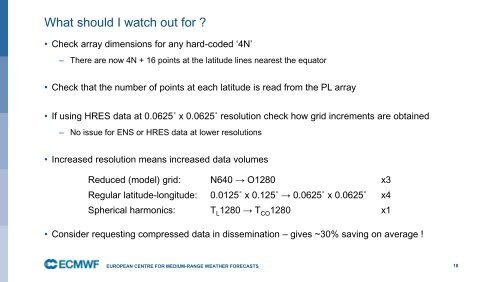Create successful ePaper yourself
Turn your PDF publications into a flip-book with our unique Google optimized e-Paper software.
What should I watch out for ?<br />
• Check array dimensions for any hard-coded ‘4N’<br />
– There are now 4N + 16 po<strong>in</strong>ts at the latitude l<strong>in</strong>es nearest the equa<strong>to</strong>r<br />
• Check that the number of po<strong>in</strong>ts at each latitude is read from the PL array<br />
• If us<strong>in</strong>g HRES data at 0.0625˚ x 0.0625˚ resolution check how grid <strong>in</strong>crements are obta<strong>in</strong>ed<br />
– No issue for ENS or HRES data at lower resolutions<br />
• Increased resolution means <strong>in</strong>creased data volumes<br />
Reduced (model) grid: N640 → O1280 x3<br />
Regular latitude-longitude: 0.0125˚ x 0.125˚ → 0.0625˚ x 0.0625˚ x4<br />
Spherical harmonics: T L 1280 → T CO 1280 x1<br />
• Consider request<strong>in</strong>g compressed data <strong>in</strong> dissem<strong>in</strong>ation – gives ~30% sav<strong>in</strong>g on average !<br />
EUROPEAN CENTRE FOR MEDIUM-RANGE WEATHER FORECASTS<br />
Oc<strong>to</strong>ber 29, 2014<br />
18


